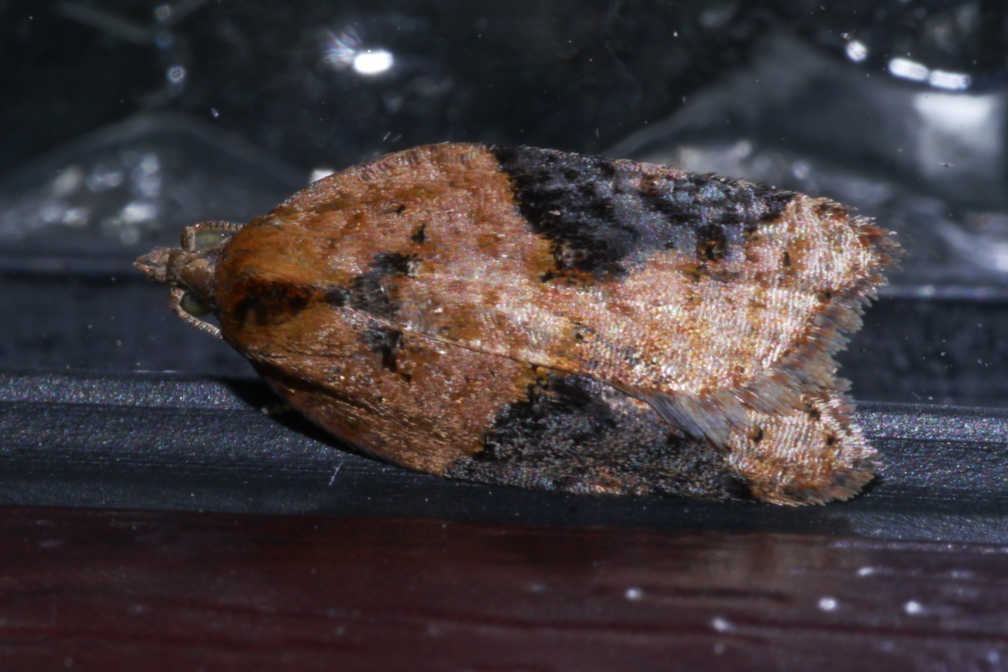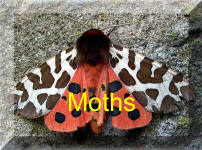ABH 49.066
Dark-Triangle Button Acleris laterana
BF 1038
Back To
(Fabricius, 1794)
Phenology
JAN
FEB
MAR
APR
MAY
JUN
JUL
AUG
SEP
OCT
NOV
DEC
Family
Tortricidae » Tortricinae
Wingspan
15-20 mm.
Description
 Another
variable species in a number of forms - Polymorphic , which is difficult
to separate from A. comariana. A rough guideline is the flight period,
which is said to be August to September in the present species,
and June/July and October/November in comariana. However, these
do overlap and genitalia dissection is usually required to be certain.
Another
variable species in a number of forms - Polymorphic , which is difficult
to separate from A. comariana. A rough guideline is the flight period,
which is said to be August to September in the present species,
and June/July and October/November in comariana. However, these
do overlap and genitalia dissection is usually required to be certain.
Certain forms of this species closely resemble forms of A. comariana,
from which reliably separated by dissection of the genitalia. The
brownish f. perplexana may be confused with f. castaneana of A.
schalleriana, but may be distinguished by the comparatively smooth
costa of the forewing [Bradley].
Form: laterana (uncommon) - ground
colour silver white with variable suffusion of grey and black scales;
markings red-brown - basal markings diffuse but sub-basal fascia
developed on dorsum, costal blotch extending to tornus, its distal
edge diffuse; terminal area sprinkled black. This form is similar
to A.comariana f. latifasciana (has this been renamed laterana?)
Form: labeculana (common) - ground
colour suffused grey; markings red-brown - basal patch represented
by a small dorsal portion of the sub-basal fascia, otherwise obsolescent;
costal blotch lunate. This form is similar to A.comariana f proteana.
Form: comparana - ground colour pale
yellow-brown; markings blackish - same pattern as labeculana. This
form is similar to A,comariana f. potentillana
Form: perplexana (common) - ground
colour grey-brown, varying considerably in shade; markings brownish
- basal patch ?obsolete, costal blotch relatively inconspicuous
and may extend to dorsum. This form is similar to A.schalleriana
f. castaneana
Life Cycle
The larva, which can be clearly distinguished
from A. comariana in later instars, feeds in May
and June on Rosaceous trees and shrubs, Salix and Vaccinium.
Habitat
Larva feeds on Willow, Bilberry, Raspberry,
Blackthorn, Rowan and similar, living within a spun or rolled leaf,
over-wintering as an egg.
Links
Images
IMAGE (C) GORDON
JACKSON 2015

ABH 49.066 |
Dark-Triangle Button Acleris laterana |
BF 1038 |
|||||||||||||
|
|
|||||||||||||||
| Back To | (Fabricius, 1794) |
||||||||||||||
|
|||||||||||||||
Phenology |
|
||||||||||||||
Family |
Tortricidae » Tortricinae | ||||||||||||||
Wingspan |
15-20 mm. | ||||||||||||||
Description |
Form: laterana (uncommon) - ground
colour silver white with variable suffusion of grey and black scales;
markings red-brown - basal markings diffuse but sub-basal fascia
developed on dorsum, costal blotch extending to tornus, its distal
edge diffuse; terminal area sprinkled black. This form is similar
to A.comariana f. latifasciana (has this been renamed laterana?) |
||||||||||||||
Life Cycle |
The larva, which can be clearly distinguished
from A. comariana in later instars, feeds in May |
||||||||||||||
Habitat |
Larva feeds on Willow, Bilberry, Raspberry, Blackthorn, Rowan and similar, living within a spun or rolled leaf, over-wintering as an egg. | ||||||||||||||
Links |
|||||||||||||||
Images |
IMAGE (C) GORDON JACKSON 2015
|
||||||||||||||
|
|
|||||||||||||||

